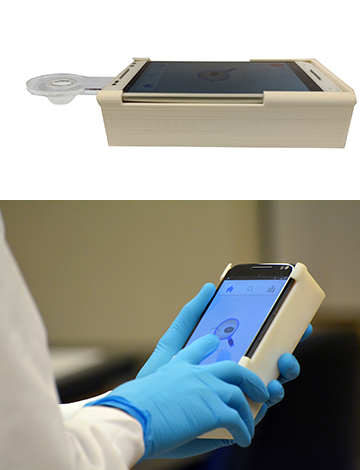
The Harvard-designed device (top) includes a 3-D printed case containing LED and aspheric optics, and a slide-in microfluidic chamber for the sample. Coupled with a smartphone app (bottom), it reportedly enables portable, cheap and fast tests for male infertility. [Images: M.K. Kanakasabapathy et al., Sci. Transl. Med. (2017); Vignesh Natarajan]
Up to 12 percent of the world’s male population suffers from infertility at some point in adult life. And, among the more than 45 million couples grappling with infertility worldwide, male infertility accounts for at least part of the problem in some 40 percent of cases. Yet the most common tests for male infertility are lab-based and expensive. And that fact, coupled with a stigma associated with infertility in some cultures, has held back diagnosis and action in many countries, particularly in resource-limited areas.
Now a team of scientists and engineers at the Harvard Medical School (USA) has developed a device that can snap onto a smartphone and, using a combination of optics and microfluidics, can deliver accurate assessments of sperm count and motility (motion) in less than five seconds, even by untrained users (Sci. Transl. Med., doi: 10.1126/scitranslmed.aai7863). The technology’s developers believe that the device—the materials for which cost less than five U.S. dollars—could eventually make testing for male infertility “as accessible, easy, fast, and private as pregnancy tests.”
From lab-size to palm-size
The current standard of diagnosis for male infertility involves a combination of microscope-based testing and computer-assisted semen analysis (CASA). That’s a costly and labor-intensive process that requires the patient to visit the hospital to provide a sample, uses bulky image-processing equipment that does not translate well to remote point-of-care settings, and calls for highly trained technicians to execute. While some potentially more flexible and cost-effective approaches have been proposed, most fall short in portability or are not capable of testing both sperm count and motility, which must be assessed together for an accurate fertility reading.
The Harvard team, led by Hadi Shafiee, believed that advances in smartphone technology, microfluidics, and micro-optics could point to a better way. To get there, they used 3-D printing to develop an external attachment into which the researchers embedded an inexpensive battery, wiring, a white light-emitting diode (LED) and two aspheric lenses for magnification, with the optical axis aimed to focus light through the smartphone camera lens. A disposable microfluidic chamber, into which semen samples can be loaded, slides into a slot in the attachment at a fixed distance from the aspheric lenses, eliminating the need for manual focusing. Total materials cost: US$4.45.
There’s an app for that
The other component of the system is a software application that captures video of the sample, at a rate of 30 fps, and automatically analyzes the images for counts of sperm cells and evidence of motility. The researchers loaded the app on a Motorola Moto X smartphone, and then put it to the test, by comparing its results with those of a full-bore, lab-based CASA setup.
The team found that the device was able to deliver sperm counts and motility data that agreed with CASA results to an accuracy as high as 97.7 percent. Moreover, the researchers tested the device with both trained and untrained users, and found no statistically significant difference in the accuracy of the results—an indication that the test could ultimately find a place in the consumer/home-health-diagnostics marketplace.
The Harvard researchers see a variety of applications for the device beyond helping infertile couples. For example, they note that men who have recently had vasectomies could use the unobtrusive test to gauge and track the surgical procedure’s post-op effectiveness at home, and that animal breeders could find use for it as well. After additional testing for the prototype, the team expects to file for approval for commercial marketing by the U.S. Food and Drug Administration.
